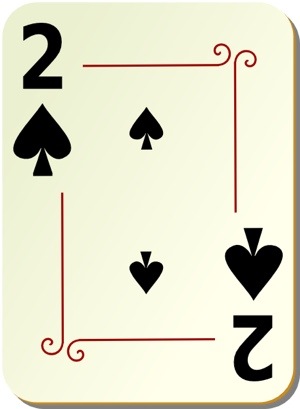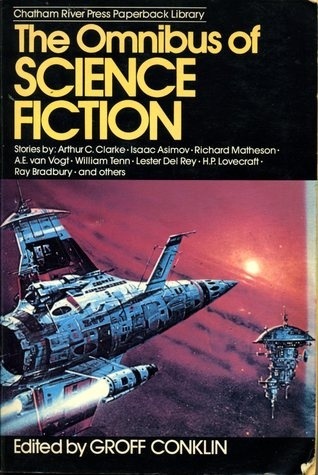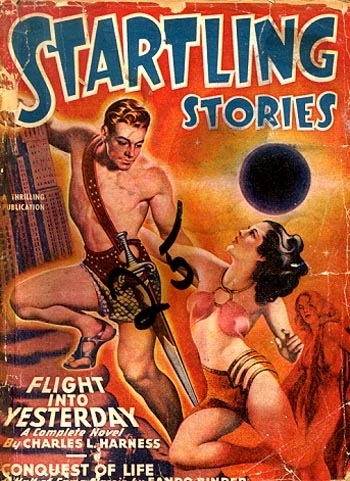The established routine for my short story reading project includes randomly selecting one story from my list each Saturday. I do this by drawing a card from my ever dwindling deck of cards (fifty-two weeks, fifty-two Saturdays, see?) Before the year began, I picked some stories to read and assigned them to the cards, with suits based loosely on categories. The stories for this year’s project are listed on my 2012 Short story selections page. https://bibliophilica.wordpress.com/2012-1-short-story-a-week-selections/
A brief explanation of how my annual project works is here https://bibliophilica.wordpress.com/2012/01/08/the-2012-deck-is-stacked/
Today, with only ten cards left, I drew the two of spades, leading me to Arthur C. Clarke’s story “History Lesson.”
I haven’t read much by Arthur C. Clarke. Certainly not as much as I should have at my age. Most famous for 2001: A Space Odyssey (seen the movie, haven’t read the book), I’ve only read a short story here and there, and I have a vague memory of reading the novel, “Childhood’s End” – or at least reading most of it. Before today, my favorite story of his would be “The Star.” I won’t discuss that story in detail now, but it is very short and could be found online here (http://www.uni.edu/morgans/astro/course/TheStar.pdf) if you’re interested in reading it. Enough talking. On to “History Lesson…”
(Arthur C. Clarke; picture from his obituary in The Telegraph)
How well do we know what the future holds? I’m not talking about the feeble “immediate” future we individuals fret over, but a more far-reaching future. Astronomers are in reasonable agreement that, billions of years from now, our sun will expand and die as it’s “fuel” runs out. This will certainly spell the end for our planet, if indeed it hasn’t fallen victim to any other fate by then. The future of Earth envisioned in this story, though, can be counted in just thousands of years, not billions or even millions.
We don’t know exactly how far in the future from now, but we do know that, due to a vaguely referred to “change in the sun’s radiation,” Earth is in the throes of a new, global ice age. The remnants of civilization are migrating southward, fleeing the relentless onslaught of advancing glaciers, finding a last, fertile plain near the equator only to see with dismay the advance of the southern glaciers. Their days are numbered. But that’s not what the story is about.
These remnants of the human species (they have lost the know-how of their former technological society, but how this came to pass is not clearly divulged) retain enough of a “sense of history” that one of their final acts is burying a kind of “time capsule” which includes in its contents some of the devices of the former technological society that they hold sacred, though don’t even understand what they are. One of these items is a still-functioning, radiation powered beacon. It attracts an extra-terrestrial attention.
What is bad for one planet could very well be good for another, and this is what happens here. Venus goes from its blast furnacey climate to a tropical and “evolutionarily friendly” one. Intelligent life takes hold and eventually hears the beacon.
The examination of the time capsule’s contents by an alien intelligence is thought-provoking. How many – and what type – of artifacts left behind by one civilization are sufficient for another to gain a good understanding of it? Naturally, this is a problem that “terrestrial” archaeologists have faced since the birth of that field. This story suggests that misinterpretations could be very likely given a small sample size…
Originally published in the May, 1949 edition of Startling Stories, it has since been republished and anthologized many times. My copy is in my collection, The Omnibus of Science Fiction, a reprint of a 1952 anthology.
I did enjoy browsing the internet this morning (it was quite awhile before I found the original publication) looking at all these old, fantastic cover art of that era. This edition’s cover was attributed to Earle Bergey (1900-1951), who specialized in covers for the pulp magazines of the day.
Read “History Lesson” online here: http://hermiene.net/short-stories/history_lesson.html
And tell me what you think of it. Have you read other Arthur C.Clarke works? Which are your favorites,or which would you recommend for future reading?




Dale said,
October 28, 2012 at 7:53 am
The only Clarke I’ve read has been 2001: A Space Odyssey. I remember enjoying it, but it didn’t blow me away. This story sounds really good. I like the cover art!
LikeLike
Jay said,
October 29, 2012 at 12:49 pm
Hi Dale,
I remember being a little disappointed with Childhood’s End, but it was so long ago I don’t remember why.
I loved looking through all those old pulp magazine covers. I’m 99% sure the one I pictured included “History Lesson”
-Jay
LikeLike
Dee said,
October 29, 2012 at 3:28 am
Dear Jay …
A little off the subject of the day but I just have to share what I just read: short story … The Grand Slam by Leonid Andreev …. about cards in a card game where each card has its own personality ….. Dee
LikeLike
Jay said,
October 29, 2012 at 12:50 pm
Hi Dee,
Wow, I must track down a copy of that one! Where did you find it? (I should make it required reading for 2013’s short story reading project…) Thanks for making me aware of it.
-Jay
LikeLike
Dee said,
October 30, 2012 at 5:01 am
The Penguin Book of Russian Short Stories edited by David Richards 1981 for The Grand Slam …
LikeLike
Jay said,
October 30, 2012 at 7:27 pm
Thanks, Dee! I will add that to the collection.
-Jay
LikeLike
hkatz said,
October 30, 2012 at 11:05 pm
The examination of the time capsule’s contents by an alien intelligence is thought-provoking. How many – and what type – of artifacts left behind by one civilization are sufficient for another to gain a good understanding of it?
Interesting. The only Clarke work I’ve read – other than Childhood’s End, years go, also have forgotten it – is The Sentinel, where astronauts find a strange construction on the moon that’s an artifact from another civilization… and they try to figure out what purpose it serves. I enjoyed The Sentinel – it’s the story on which 2001: A Space Odyssey was based (though the novel I’ve heard is much different). I recommend it – the descriptions of the moon’s terrain in The Sentinel are especially beautiful.
LikeLike
Jay said,
November 6, 2012 at 8:00 am
Hi hkatz,
Thanks for the recommendation. I’ll look for The Sentinel. (seems like I should say The Sentinel will look for me!). You should check out The Star. Very short and also good.
Jay
LikeLike
Cian Beirdd said,
April 15, 2013 at 11:06 pm
I’ve read a lot of Clarke. Brilliant man with a disciplined mind. Every story is fully humanized, with unique technology, approaches to the supernatural, humor, and a biting sense of reality that never seems to allow for a happy ending. I always learn a lot wading him. I am delighted so many other people think he is still worth reading.
LikeLike
Jay said,
April 16, 2013 at 10:30 am
Thanks for the comment, Cian. Any recommendations for my next Clarke reading?
LikeLike